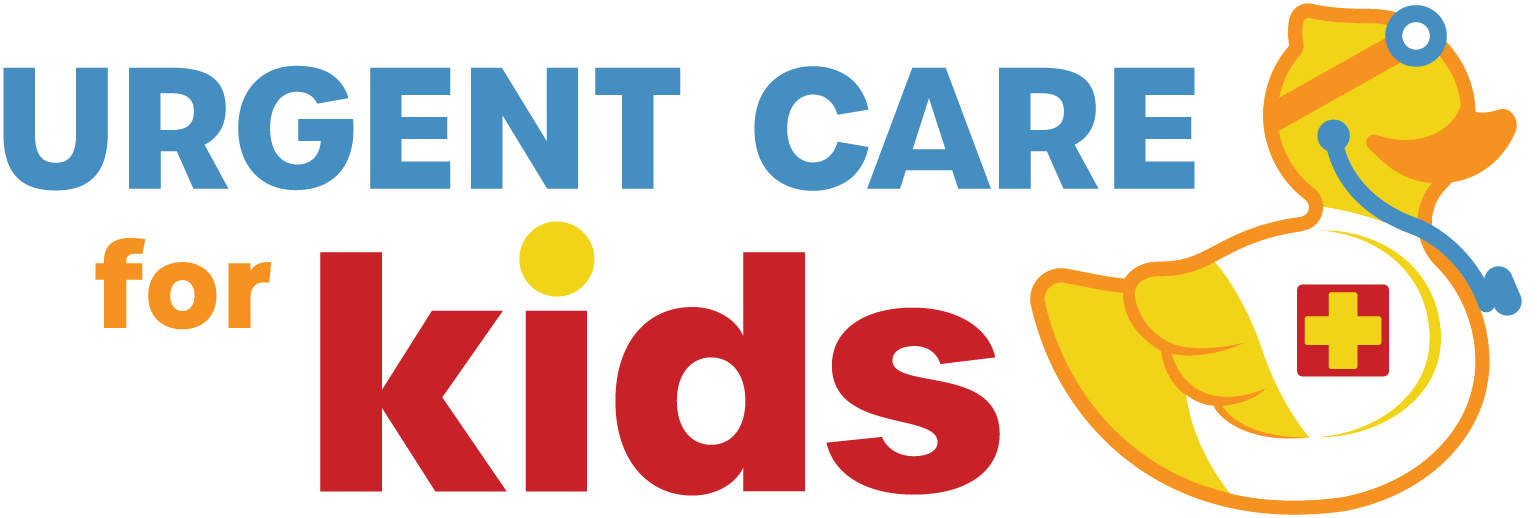Summer is all about fun in the sun, pool days, family adventures, and making unforgettable memories. But as temperatures rise, so do the risks that can affect your child’s health.
At Urgent Care for Kids, we want to help your family enjoy every moment of summer safely. From protecting little ones from sunburns and heat-related illnesses to staying hydrated, swimming safely, and managing tummy troubles, we’re covering all the key tips to keep your kids happy and healthy all season long.
 Child Sun Protection Tips for Summer
Child Sun Protection Tips for Summer
Staying protected from the sun’s powerful UV rays is the best way to prevent melanoma (skin cancer). Follow these tips for maximum sun protection all summer long.
- Sunscreen: Look for a broad-spectrum sunscreen with an SPF of 30 or higher that is also water-resistant. Reapply every 2 hours, or 40–80 minutes if they are playing in the water.1
- Hats & Long Sleeves: Sun hats and ball caps are a great way to protect your kid’s face during the summer. If they are more prone to sunburns, try a lightweight long-sleeve shirt to protect their shoulders and arms.
- Shaded Areas: If your kids are playing at the park or even in the backyard, keep an eye on them and make sure they aren’t playing in direct sun for too long. Encourage them to find shaded areas, like under a tree, when they start to feel hot.
 Summer Hydration Tips for Kids
Summer Hydration Tips for Kids
Drinking plenty of water is essential to preventing heat-related illnesses during the hottest months of the year. Try electrolyte drinks like coconut water or sports drinks (e.g. Gatorade or Powerade) for an extra boost of hydration. Water intake varies by age, so be sure your kids are drinking enough.2
- 1–3 years old: 4 cups of water per day
- 4–8 years old: 5 cups of water per day
- 9–13 years old: 7–8 cups of water per day
- 14–18 years old: 8–11 cups of water per day
 Recognizing and Preventing Heat Stroke in Children
Recognizing and Preventing Heat Stroke in Children
Did you know that kid’s bodies heat up 3–5x faster than adults which puts them at a great risk for heat stroke? When the heat index is 105°F or higher, heat stroke can happen fast. Summer athletes, children under 4 years old, and kids with chronic conditions (like heart disease, hypertension, diabetes, and mental illness) are most at risk.3
- Symptoms: Dry/flushed skin, fast breathing, headache, dizziness, confusion, slurred speech, cramps, nausea, vomiting, loss of consciousness, and even seizures in severe cases.
- Prevention: Drink plenty of water (see above), wear light-colored and loose clothing, remind kids to look for shaded areas, wear sunscreen and hats, no intense outdoor activities during the hottest hours, teach kids to come inside when they feel too hot, and NEVER leave kids alone in a parked car.
 Drowning Prevention and Safe Swimming Tips for Kids
Drowning Prevention and Safe Swimming Tips for Kids
Drowning is silent, fast, and thankfully totally preventable. It often happens when multiple adults assume someone else is watching the kids in the water. Whether it’s a pool, lake, ocean, or even a bathtub, swim safety and drowning prevention are necessary for your kid’s safety.4
- Swim Protection:
- Sign up for swim lessons and/or infant swimming resource (ISR).
- Utilize door locks, alarms, pool fences, and covers to prevent kids from accidentally going in the water unsupervised.
- Don’t forget swim floaties for young kids and a designated water watcher to keep an eye out for any dangers.
- Facts About Drowning:
- Leading cause of death for kids ages 1–4.
- Often silent with no splashing or screaming.
- Happens fast while you’re looking away, sending a text, or grabbing something from the kitchen.
- Non-fatal drownings can still have long-term effects due to the brain going without oxygen for an extended period of time.
- Knowing CPR saves lives. Click here for a guide to proper CPR techniques.
 Preventing Summer Stomach Bugs in Children
Preventing Summer Stomach Bugs in Children
Nothing ruins summer fun like a stomach bug (norovirus)! Norovirus can cause dehydration, vomiting, and fatigue, which are only made worse during the hot summer months.5
- Wash Hands Regularly: After using the toilet, before eating or handling food, and before administering medication to yourself or your kid. (hand sanitizer is NOT a replacement for hand washing!)
- Prepare Food: Wash fruits and vegetables, cook oysters and other shellfish to an internal temperature of at least 145°F, routinely clean kitchen utensils and surfaces, and throw out any food you suspect may be bad.
- Clean Clothes: If there’s any item of clothing with vomit or poop on them, remove immediately and wash them with detergent and hot water. Then dry at the highest heat setting. Make sure to use rubber or disposable gloves and wash your hands thoroughly afterwards with soap and water.
No matter how your family is spending the summer, a little preparation goes a long way in keeping your kids safe and healthy. And if something unexpected does come up — whether it’s a sunburn, dehydration, tummy trouble, or a minor injury — Urgent Care for Kids is here to help.
Book your same-day visit online here at any of our 23 clinics across Texas — we’re open late, weekends, and holidays! If you’re not near our clinic or just can’t make it in, we offer convenient at-home telemedicine to all Texas families available every day from 9am–9pm. Click here to schedule your appointment today.
Resources:
- Nemours KidsHealth. How to Choose & Use Sunscreen. July 2021.
- Children's Health. Hydration tips for children.
- Columbia University Irving Medical Center. Heat Stroke in Kids: What to Watch For and Know. July 18, 2023.
- CDC. Preventing Drowning. October 16, 2024.
- CDC. How to Prevent Norovirus. January 13, 2025.
FAQ
Q: How often should I reapply sunscreen on my child?
A: Every 2 hours, or every 40–80 minutes if they’re sweating or swimming. Choose SPF 30+ and broad-spectrum coverage.
Q: What are signs of heat stroke in children?
A: Symptoms include red or dry skin, rapid breathing, headache, confusion, nausea, vomiting, slurred speech, or seizures. Heat stroke is a medical emergency.
Q: How much water should my child drink during summer?
A: 1–3 years: 4 cups/day. 4–8 years: 5 cups/day. 9–13 years: 7–8 cups/day. 14–18 years: 8–11 cups/day. Use coconut water or sports drinks for extra electrolytes when needed.
Q: What are the best ways to prevent drowning?
A: Always supervise kids in/near water. Enroll them in swim lessons. Install pool safety barriers. Assign a dedicated water watcher. Use swim aids (floaties, life vests). Learn and keep CPR skills updated.
Q: What should I do if my child gets a stomach bug in summer?
A: Keep them hydrated, monitor for signs of dehydration (dry mouth, no tears, fatigue), and visit an urgent care clinic if symptoms persist. Norovirus is a common cause.
At a Glance
- Sun Safety: Use SPF 30+ sunscreen, hats, and lightweight clothing; reapply sunscreen every 2 hours or after swimming.
- Hydration: Ensure kids drink 4–11 cups of water daily (based on age); add electrolytes for extra hydration.
- Heat Stroke Prevention: Avoid peak heat, dress in light clothing, stay in shade, and never leave kids in cars.
- Swim Safety: Enroll in swim lessons, use pool fences and floaties, and assign a dedicated water watcher.
- Stomach Bug: Prevent norovirus by washing hands with soap, cooking food properly, and cleaning contaminated clothes with hot water and detergent.
- Urgent Care: 23 Texas locations + telemedicine available daily, 9am–9pm.



